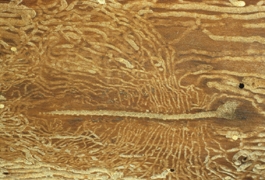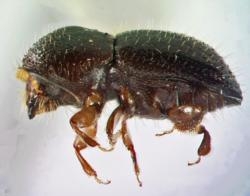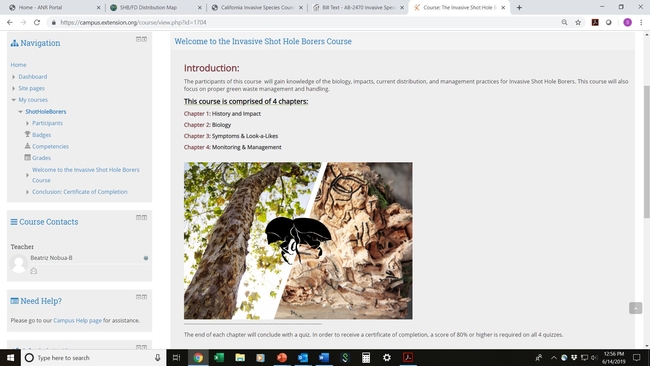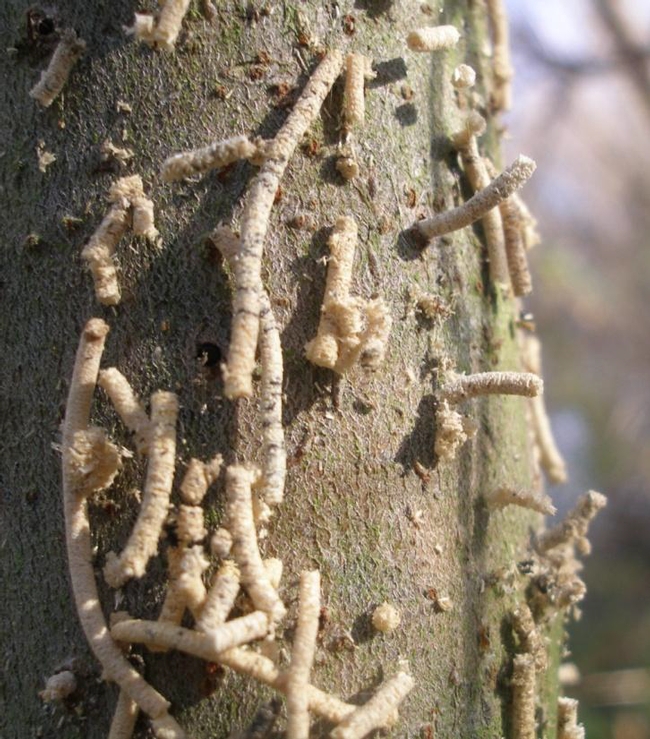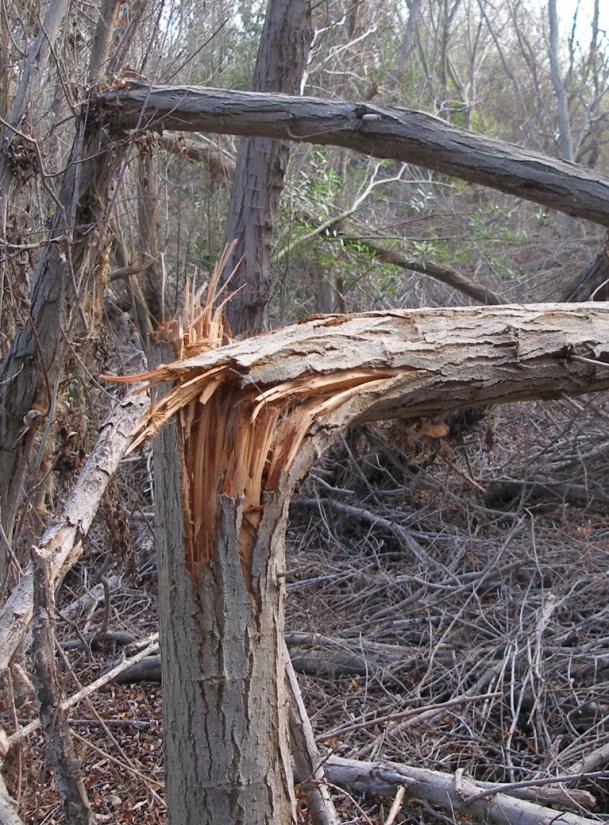- Author: Ben Faber
Update on invasive shot hole borers: Online training now available
By Sabrina Drill, Natural Resources Advisor, UCCE Ventura
Invasive shot hole borers (ISHB) are a pest and disease complex potentially affecting over 200 tree species, but posing a strong risk to box elders, sycamores, and other riparian and urban trees, as well as being a nuisance pest for avocado. The beetles have also been shown to attack a wide variety of common and less common ornamental species. For a complete host list, visit https://ucanr.edu/sites/pshb/overview/SHB_Reproductive_Hosts/. The tiny beetles burrow into the trunks and branches of trees and create galleries where they cultivate a fungus that utilizes the trees own circulatory system, harming and in some cases killing the tree. We know the beetle can reproduce in over 60 species of trees, and they have devasted natural riparian areas, though we are beginning to see recovery of some infestations. Currently, the most effective management method is to remove infested wood, sometimes entire trees, and chip what is removed to minus 1”.
ISHB are now firmly established in Ventura County, with finds throughout the Santa Clara River Valley in traps from South Mountain to Toland Park in Santa Paula, and several infested box elder and sycamores in Meiner's Oaks and Ojai. It appears not to have crossed into the county in the south, but there are still active infestations in western Los Angeles County.
Personnel from UC ANR, CDFA, the Ventura County Agricultural Commissioner, and the US Forest Service have taken lead roles in developing a statewide ISHB action plan for the California Invasive Species Advisory Committee, with an initial investment of $5 million to work on controlling the pest. Plan elements include research in the ecology and control of the pest, including work to develop biocontrol; an early detection and surveillance program; addressing green waste and other pathways of spread, and outreach and education.
In terms of education and outreach, an area where Cooperative Extension in Ventura, LA, Orange, and San Diego counties have led, we're excited to announce the release of a new on-line training course. Available through our website, https://ucanr.edu/sites/pshb/, the course is actually served by the eXtension on-line learning platform (and users will need to create a free account). The course consists of 4 chapters including history and impacts, biology, symptoms and look-alike pests, and monitoring and management. While it can't fully replace a field training, it can be a good way to familiarize new staff to the issues.
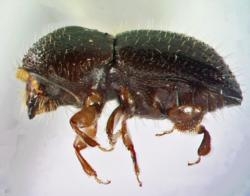
- Author: Ben Faber
Impacts of the invasive shot hole borer (Euwallacea kuroshio) are linked to sewage pollution in southern California: the Enriched Tree Hypothesis
By: John M. Bolandand Deborah L. Woodward
https://peerj.com/articles/6812.pdf
The Kuroshio Shot Hole Borer (KSHB, Euwallacea kuroshio) and the Polyphagous Shot Hole Borer (E. whitfordiodendrus; Coleoptera: Curculionidae: Scolytinae) have recently invaded southern California and are attacking live trees in commercial agriculture groves, urban parks and native riparian forests. Among native forests the worst impacts observed to date have been in the Tijuana River Valley in south San Diego County, where approximately 30% of the native willows (Salix spp.), or120,000 trees, have died as a result of a KSHB infestation. This paper examines wood densities, wood moisture contents, KSHB infestation rates, and KSHB-induced mortality rates in two willow species (Salix lasiolepis and S. gooddingii) at sites near and far from sewage input. Comparisons were made on two spatial scales: broadly among sites within San Diego County; and locally among sites within the Tijuana River Valley. The results showed that, on average, willow trees growing closest to sewage pollution had significantly lower wood density, higher wood moisture content, higher KSHB infestation rates, and higher KSHB-induced willow mortality rates than those growing farther away. We present the Enriched Tree Hypothesis to explain the link between sewage pollution and KSHB impacts; it is as follows: (A) Riparian trees subject to nutrient enrichment from frequent sewage pollution grow quickly, and their fast growth results in wood of low density and high moisture content. If attacked by the KSHB, the trunks and branches of these nutrient-enriched trees provide an environment conducive to the fast growth of the symbiotic fungi upon which the KSHB feeds. With an abundant food supply, the KSHB population increases rapidly and the trees are heavily damaged by thousands of KSHB galleries in their trunks and branches. (B) Riparian trees not subject to frequent sewage pollution grow more slowly and have denser, drier wood. Conditions in their trunks and branches are not conducive to the fast growth of the KSHB's symbiotic fungi. The KSHB generally ignores, or has low abundances in, these slow-growing trees. This new hypothesis explains current patterns of KSHB impact in San Diego County and focuses attention on the important roles of the environment and preexisting conditions of trees in determining the extent of KSHB impact .It highlights the Tijuana River Valley as an unusual site due to high sewage inputs and predicts that the high KSHB-induced willow mortality seen there should not occur in other natural riparian habitats in southern California. Most importantly, by identifying sewage pollution (or nutrient enrichment) as a major risk factor for KSHB impacts, the hypothesis ratchets down the KSHB-threat level for most riparian sites in southern California and directs attention to other nutrient-enriched sites as those most at risk.
The complete article can be found at:
https://peerj.com/articles/6812.pdf
Two newly published scientific journal articles that address SHB species delineation are:
- Gomez et al. Species Delineation Within the Euwallacea fornicatus. in Insect Systematics and Diversity, (2018) 2(6): 2; 1–11. (Attached) Richard Stouthamer and Paul Rugman-Jones, both with UC Riverside, are two of the co-authors
- Hulcr, J & Landers, J. January 7, 2019. So Many Shot Hole Borers: New research charts four nearly identical species. in Entomology Today. https://entomologytoday.org/2019/01/07/so-many-shot-hole-borers-new-research-charts-four-nearly-identical-species/
Examples of ambrosia beetle impact on willows. (A top) KSHB excavate galleries within a trunk and push the sawdust tailings out of their entrance holes. (B lower) Trees can be undermined by many galleries and snap in high winds. [These pictures show the extremes – infested trunks do not always look like A, and infested trunks do not always break, like B. Images: John Boland]
- Author: Tunyalee Martin
UC ANR Integrated Pest Management Program
A sugar volcano is one symptom that shows your avocado tree might be infected with Fusarium dieback, a fungi spread by a beetle called the shothole borer. But what you might see if your tree is being attacked by shothole borer, varies among the different kinds of tree hosts. The symptoms—staining, sugary exudate, gumming and beetle frass—are often noticed before the tiny beetles (1.5–2.5 mm) are found.
As its name suggests, these beetles bore into trees. Near or beneath the symptoms, you might notice the beetle's entry and exit holes into the tree. The female tunnels into trees forming galleries, where she lays her eggs. Once grown, the sibling beetles mate with each other so that females leaving the tree to start their own galleries are already pregnant. Males do not fly and stay in the host tree.
Shothole borers have a special structure in their mouth where they carry two or three kinds of their own novel symbiotic fungi. Shothole borers grow these fungi in their tree galleries. It's these fungi that cause Fusarium dieback disease, which interrupts the transportation of water and nutrients in the host tree. Advanced fungal infections will eventually lead to branch dieback.
Early detection of infestations and removal of the infested branches will help reduce beetle numbers and therefore, also reduce the spread of the fungus.
- Chip infested wood onsite to a size of one inch or smaller. If the branch is too large to chip, solarize them under a clear tarp for several months
- Avoid movement of infested firewood and chipping material out of infested area
Avocado is one tree host. Shothole borers successfully lay eggs and grow fungi in many tree hosts, with some of these trees susceptible to the Fusarium dieback disease. For more information about tree host species, where the shothole borer is in California, and what symptoms look like in other tree hosts, visit the UC Riverside Eskalen Lab website.
Californians can help in the fight against invasive species by learning and participating during California Invasive Species Action Week, June 2–10.
During the week, spend your lunch with us learning the latest about invasive tree killing pests, aquatic nasties like quagga mussels and nutria, and how the invasive weed/wildfire cycle is altering our ecosystems! http://ucanr.edu/sites/invasivelunch/
Content in this post taken from the UC IPM Avocado Pest Management Guidelines. Faber BA, Willen CA, Eskalen A, Morse JG, Hanson B, Hoddle MS. Revised continuously. UC IPM Pest Management Guidelines Avocado. UC ANR Publication 3436. Oakland, CA.
And more about Shot Hole Borers
http://ucanr.edu/sites/pshb/
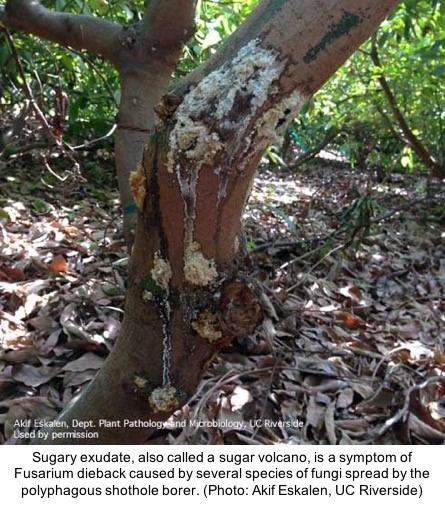
- Author: Ben Faber
Los Angeles County Spring 2018 ISHB/GSOB Field Trainings
Registration now open
Learn how to recognize the signs of invasive shot hole borer and gold spotted oak borer infestations in native and landscape trees. Each training will cover how to recognize signs, symptoms, active and inactive populations, take field samples, treatment options, proper handling and disposal of green waste.
- Huntington Gardens, Tuesday May 8, 10:30 - 12:30
training entrance: 1800 Orlando Avenue, San Marino CA 91108
2) O'Melveny Park, Thursday May 17, 10:00 - 12:00
17300 Sesnon Blvd, Granada Hills CA 91344
The events are free, but registration is limited. To register, go to www.pshb.org and click on the calendar entry, or go directly to http://ucanr.edu/sites/gsobinfo/News_and_Events/GSOB_Training_Event_Registration/?editon=0
These trainings were initially offered as part of a series with two live webinars, which have now past – if you did not attend the webinars, unfortunately, these trainings alone will NOT offer CEUs.
AS OF 5/3/2018, THE ONLY FIELD TRAINING WITH SPACE REMAINING IS THURSDAY, MAY 17TH, O'MELVENY PARK, LOS ANGELES COUNTY. IF YOU CANNOT ATTEND THIS TRAINING, DO NOT REGISTER.
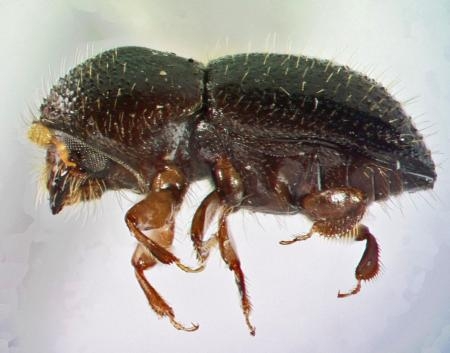
- Author: Ben Faber
Many growers don't hear about the amount of research and extension activity that is going on surrounding the Shot Hole Borers and Fusarium Dieback. This pest/disease complex affects not only avocados, but many other tree species, including many California natives. These are the notes from a Collaborative organized by UC ANR. There is a lot of energy by a lot of groups addressing this massive problem.
Invasive Shot Hole Borer (Polyphagous and Kuroshio)/Fusarium Dieback
Quarterly Situation Report
January 1 through March 31, 2017
Executive Summary
Overview
No spread of invasive shot hole borer/Fusarium dieback (ISHB/FD) was reported this quarter, which may have been due to cool seasonal temperatures and resulting insect inactivity. The period served to establish new trapping sites, evaluate programs, and establish new ones.
Trapping locations expanded in Orange, Ventura, and Santa Barbara Counties. A new trapping program was started that serves the Santa Monica Mountains, Conejo and San Fernando Valleys.
An urban observational project modeled after successes in Orange County was initiated in Ventura County. The project can potentially expand monitoring by citizen scientists throughout the region to benefit tracking and treatment.
Representatives of various public, academic, and private entities from seven of the nine southern California counties participated in activities, which are summarized below
Statewide
o ISHB/FD dialogue continued between counties, Agricultural Commissioners, and other stakeholders through conferencing hosted by the California Agricultural Commissioners and Sealers Association. Education and outreach to counties without infestations is tantamount for detection and readiness
o Outreach was initiated to Inyo and Mono Counties in eastern California
o Legislative outreach and education continued to State Assembly and California Department of Food and Agriculture
o California Department of Fish and Wildlife hired staff for ISHB monitoring, trapping, developing a wildlands field guide, and creating a management matrix
o Media interviews about ISHB/FD were conducted for publications, many of which are circulated online.
Regional
o Two ISHB/FD working groups met:
- Emerging Tree Pests Education& Outreach Subcommittee (5x)
- Natural Resources/Urban Forest SHB Coalition (3x)
o University of California (UC) researchers continued investigations with bio-control agents and pesticides to combat ISHB/FD
o A UC publication focused on ISHB/FD invasion to palm trees was published
San Diego County
o The Resource Conservation District of San Diego researched funding to continue ISHB/FD monitoring, trapping, education, and outreach needs
o Southwest Wetlands Interpretive Association continued studying the SHB infestation and found that an estimated 88% of plant material in the Tijuana River Valley was affected despite recovery following massive SHB-caused dieback in 2016
o UC-ANR & the Emerging Tree Pests Education and Outreach Subcommittee organized and presented the Southern California Green Waste and Wood Biomass Symposium held in San Diego
Riverside County
o California Association of Certified Pest Control Advisors and University of California Agriculture and Natural Resources Division (UC-ANR) presented a half-day ISHB/FD workshop in Temecula
o ISHB/FD training for State Parks rangers from the Inland Empire District was held in La Quinta
Orange County
o California Department of Fish & Wildlife added new trapping and monitoring sites that included nature preserves, large institutional campuses, and parkways
o California State Parks trapped at Crystal Cove, with no positive finds
o ISHB/FD training was conducted for US Fish & Wildlife Service staff
o Monitoring protocols for oak and sycamore were developed for the 4000-acre Audubon Starr Ranch in Trabuco Canyon
o Orange County Master Gardeners received ISHB/FD training
o Orange County Parks expanded trapping and monitoring activities to more parks, with Irvine Regional Park a focal point
o Outreach continued throughout the county, with added focus to the business community
Los Angeles County
o The Huntington continued monitoring its 207-acre parcel
o The Resource Conservation District of the Santa Monica Mountains (RCDSMM) initiated trapping in the Santa Monica Mountains with partner National Park Service (NPS) – Santa Monica Mountains National Recreation Area
o RCDSMM conducted trap making and trapping workshops for trapping in the San Fernando Valley and Santa Monica Mountains
o UC-ANR met with City of Downey staff to discuss current infestations and monitorin
Ventura County
o California Association of Certified Pest Control Advisors and University of California Agriculture and Natural Resources Division (UC-ANR) presented a half-day ISHB/FD workshop in Ventura
o Master Gardener urban observation project began
o RCDSMM and NPS established trapping sites in the Santa Monica Mountains/Conejo Valley area
o UC Santa Barbara and UC-ANR coordinated an all-day meeting of the Santa Clara River Academic Coalition to discuss research being conducted in the watershed
o Ventura County Agricultural Commissioner continued monitoring traps at avocado orchards in the Santa Paula area
o UCSB continued trapping in riparian areas in the Santa Clara River watershed and started establishing sites in the Ventura River corridor
Santa Barbara County
o Santa Barbara County SHB Working Group met (1x)
o UC-ANR education and outreach was delivered by print and online media, tabling, and public events
o UC-ANR met with Montecito Fire Department and the Santa Barbara County Fire Safe Council to discuss ISHB/FD threat
o UCSB/UCR continued monitoring traps in the Montecito area and established new sites in the City of Santa Barbara foothills
San Luis Obispo County
o CAL FIRE explored funding for trapping, monitoring, education and outreach
PSHB Working Group Coordination
Active groups – regionwide
o There are currently nine working groups focused on shot hole borers. PSHB/KSHB updates and discussions on research, education and outreach strategies took place during group coordination meetings held, in person and via conference calls:
- CACASA – California Agricultural Commissioners and Sealers Association (J. Deviney, Agricultural Commissioner-Santa Clara County group conference call facilitator - 3/22)
- Emerging Tree Pests Education and Outreach Committee (A. Cornejo, US Fish & Wildlife Service, facilitator – 1/25, 2/8, 2/22, 3/8, 3/22)
- Natural Resource / Urban Forestry Shot Hole Borer Coalition (Chaired by California Department of Fish and Wildlife – G. Sevrens, facilitator – 1/3, 2/7, 3/7)
- Orange County Emerging Tree Pests Group
- San Diego Association of Governments – Emerging Tree Pests Subcommittee (SANDAG)
- Santa Barbara County Shot Hole Borer Working Group (M. Bianchi, University of California Cooperative Extension – Santa Barbara & San Luis Obispo Counties – group facilitator, 3/23)
- University of California Emerging Tree Pests Working Group – statewide for ISHB – (S. Drill, University of California Cooperative Extension – Los Angeles & Ventura Counties – group facilitator, 3/9)
- Ventura County Green Waste and Pest Prevention Advisory Committee
- Ventura County Polyphagous Shot Hole Borer Working Group (S. Drill, University of California Cooperative Extension – Ventura – group facilitator)
John Boland, Southwest Wetlands Interpretive Association (SWIA) – Imperial Beach
o Continued studying KSHB in the Tijuana River Valley riparian forest, with funding from the US Navy and US Fish & Wildlife Service
Sabrina Drill, UC Cooperative Extension – Ventura & Los Angeles Counties
o Met with Santa Clara River Academic Coalition to discuss SHB research, monitoring, trapping efforts in the watershed – (3/1)
o Coordinated Cooperative Extension/UC Riverside SHB coordination working group meeting in Riverside – (3/9)
o Participated in California Agricultural Commissioners & Sealers Association (CACASA) statewide call – (3/22)
Tom Dudley, UC Santa Barbara – Marine Science Institute
o Coordinated Santa Clara River Academic Coalition meeting for the watershed – (3/1)
Jan Gonzales, UC Cooperative Extension – San Diego
o Participated in Coordinating Work Group Meetings/Calls:
- Natural Resources/Urban Forestry SHB Coalition (1/3, 2/7, 3/7)
- Emerging Tree Pests Education and Outreach Committee (1/25, 1/11, 3/8, 3/22)
- Statewide PSHB Group (3/22)
o Coordinated visit to the San Diego Zoo and gave briefing on ISHB during field tour for UC ANR's Associate Vice President, Wendy Powers; Chris Greer, Vice Provost of Cooperative Extension and guests from the National eXtension program (1/24)
Funding, Legislation, Planning, Policy and Regulation
John Kabashima, UC Cooperative Extension – Orange County
o Gave a team talk with the California Department of Food and Agriculture (CDFA) Director of Plant Health to the Invasive Species Council of California (ISCC) on PSHB/KSHB/FD as an example of emerging tree pests that the present system isn't addressing effectively. Ideas to address this by CDFA and the ISCC Advisory committee are incorporated in their interagency "Charting the Pest Prevention System in California" plan. The California Assembly Speaker's office suggested we identify an Assembly Democrat who would ask the State agencies to address this issue and recommend a plan and budget. This would be determined through either a special summit meeting or Assembly hearing. Several approachable Assemblymembers were identified to collaborate on this matter (1/5)
o Discussed SHB funding needs with collaborators, including the Resource Conservation District of San Diego County, University of California Cooperative Extension San Luis Obispo
Surveying/Monitoring/Detection/Mapping
Dan Berry & Tim Thibault, The Huntington Gardens – Pasadena
o Continued plant collection monitoring for 207 acres
Rosi Dagit, Resource Conservation District (RCD) of the Santa Monica Mountains – Topanga
- Conducted Santa Monica Mountains SHB trapping coordination meeting with the RCD and Santa Monica Mountains National Recreation Area staff (1/24)
- Taught a SHB trap making and monitoring workshop at Malibu Creek State Park for– (3/1
- Sandy De Simone, California Audubon – Trabuco Canyon
o Met with Audubon Starr Ranch seasonal riparian assistants in January to devise a protocol for monitoring oaks and sycamores for pests and disease on the 4,000 acre property located in southeast Orange County
Sabrina Drill, UC Cooperative Extension, Ventura and Los Angeles Counties
o Met with UCCE Ventura Master Gardener Program Coordinator Leah Hanson to discuss upcoming SHB observational training and urban monitoring sites throughout the county as part of the new Tree Detective program in sycamores – 3/27/17
John Kabashima, UC Cooperative Extension - Orange County
o Discussed SHB infestations and monitoring with City of Downey officials (1/18)
Lana Nguyen, State Parks – Orange Coast District
o Received confirmation from the Eskalen Lab that tree specimen from Crystal Cove was negative for Fusarium dieback
Cathy Nowak, Orange County Parks – Irvine
o UCCE completed surveys & mapping for Aliso & Wood Canyons Wilderness Park, Key Ranch, Heritage Hill, and O'Neill Regional Park to Oso Parkway
o Monitoring continues at Irvine Regional Park
o Twelve monitoring stations were established at Whiting Ranch Wilderness Park – Trabuco Canyon
Gail Sevrens, California Department of Fish & Wildlife, South Coast Region – San Diego
o Hired two new Scientific Aides, Ryan Lawler and Aidan Renner. They are assembling an expanded field guide to identifying SHB in wildland settings as well as a management matrix to determine the best course of action in the event that it is found. Theywill begin monitoring and trapping for SHB in the region
o Worked with the SHB Survey Committee, to investigate what kind of and how frequently surveys are being done
Research Activities and Findings
Dan Berry and Tim Thibault, The Huntington – Pasadena
o Traveled with Akif Eskalen and Richard Stouthamer to Taiwan for the purpose of PSHB bio-control and insect agents (January)
o Finalized stress test with Colin Umeda (UC Riverside)
John Boland, Southwest Wetlands Interpretive Association (SWIA) – Imperial Beach
o The Tijuana River Valley is the first natural habitat to be substantially invaded by the KSHB. It first appeared in the valley in 2015 and almost immediately caused extensive damage to the riparian forests. It is estimated a total of 355,510 willows, or 88% of the population in the valley, have already been infested. More than two billion (2 x 109) beetles were born in the valley during 2015-16. This was likely the single largest production of offspring by this beetle in the US so far.
o KSHB has not killed all of the willow trees it infested. Many heavily damaged by the KSHB during 2015 re-sprouted in 2016. In some sites, where the willow canopy was destroyed by the KSHB, there is now an extensive short canopy of re-sprouting willow “shrubs” up to four meters tall.
o A final report on this research will be released in April 2017
Tom Dudley, University of California Santa Barbara – Marine Institute
o Interfaced with Institute staff and graduate researchers to monitor, trap, and research SHB in Santa Barbara and Ventura Counties
o Attended an interagency invasive species meeting in January on the east coast, noting several talks and posters on SHB. There is a continued research effort on semiochemicals, which UCSB may be involved at the research testing level
Akif Eskalen, UC Cooperative Extension – Riverside County
o Traveled with Richard Stouthamer (UC Riverside), Dan Berry and Terry Thibault (both from The Huntington) to Taiwan for the purpose of PSHB bio-control and insect agents (January)
Nathan Gregory, Irvine Ranch Conservancy – Irvine
o The Irvine Ranch Conservancy surveyed lower Agua Chinon at Limestone Canyon Nature Preserve in Silverado (northern Orange County foothills) and found no signs of PSHB. However, 12 potentially infested trees were identified in Bommer Canyon Community Park, Irvine (near Turtle Ridge) with samples taken and submitted to the Eskalen Laboratory at UC Riverside. Of those 12, five were surveyed last year and found to be newly infested this year. The other seven are newly surveyed this year.
Cathy Nowak, Orange County Parks – Irvine
o Tim Paine continued pesticide treatments at Mason Regional Park - Irvine that examine five treatments on ten trees. Focus is on compounds that have shown promise in previous trials at UC Irvine and in the laboratory
o Akif Eskalen's final report on the pesticide trials conducted at three regional parks is forthcoming
Richard Stouthamer, UC Riverside
o Traveled with Akif Eskalen (UCCE-Riverside), Dan Berry and Terry Thibault (both from The Huntington) to Taiwan for the purpose of PSHB bio-control and insect agents (January)
Management and Restoration
Dan Berry and Tim Thibault, The Huntington – Pasadena
o Removed and replaced two PSHB-infested Quercus robur (English oak)
Gail Sevrens, California Department of Fish and Wildlife (CDFW), South Coast Region – San Diego
o Inquired about trunk injection of pesticides on creek banks and in dry creek beds. CDFW pesticide unit was consulted. Learned that applications consistent with label instructions are alright to use, as long as trees are not growing in the water. Can be okay if next to water. Said ecological risk outweighs risk of insects.
o Updating and gathering input on Southern California Shot Hole Borers/Fusarium Dieback Management Strategy for Natural and Urban Landscapes
Wood Utilization, Sanitization, and Disposal
Dan Berry and Tim Thibault, The Huntington – Pasadena
o Continued PSHB-infested green waste grinding and material redistribution
Education and Outreach/Media Coverage
Dan Berry and Tim Thibault, The Huntington – Pasadena
o Gave PSHB presentation to 20 physicians at the Huntington Medical Research Institute
o Engaged with Earthwatch during an extended meeting about a citizen science initiative
Mary Bianchi, UC Cooperative Extension – Santa Barbara & San Luis Obispo Counties
o Began education and outreach in the greater Santa Barbara area following first population of KSHB located in Montecito. Wrote and published two online articles:
- http://www.news.ucsb.edu/2017/017516/holy-guacamole
- https://www.edhat.com/site/tidbit.cfm?nid=179674
o Met with Kerry Kellogg from Montecito Fire and some of their staff, along with UC statewide Fire Specialist Max Moritz (1/17)
o Articles will be published in the Montecito Journal, newsletters of the Montecito Association, Ennisbrook Homeowner's Association, and Westmont College
o Gave a presentation at the Santa Barbara Fire Safe Council Meeting (2/16)
o Outreach and tabling were conducted at the Montecito Farmer's Market and Lotusland in Montecito
California Association of Pest Control Advisers (CAPCA) – Sacramento
o Hosted two half-day SHB educational events for agricultural and general audiences:
- January 25 in Ventura
- January 26 in Temecula
- Speakers included UC entomology experts Richard Stouthamer, Akif Eskalen, Frank Byrne, Tim Paine, and John Kabashima
Julie Clark De Blasio, UC Cooperative Extension – Ventura
o Participated
in bottle-trap making workshop at Malibu Creek State Park (3/18). Traps will be set in wildland-urban interface areas of Brentwood in the Santa Monica Mountains
Rosi Dagit, Resource Conservation District (RCD) of the Santa Monica Mountains – Topanga
o Coordinated a half-day SHB bottle-trap making workshop at Malibu Creek State Park (3/18). The 15 participants will support trapping efforts in the Santa Monica Mountains and San Fernando Valley
Sabrina Drill, UC Cooperative Extension – Ventura & Los Angeles Counties
o Gave interview for California Agricultural Pest Control Advisers (CAPCA) video series on SHB (1/25)
o Gave interview for ‘Central Coast Farm and Ranch'(2/3):
- Bug at Bay story published Spring 2017, V14N3, pp6-8
Tom Dudley, University of California Santa Barbara – Marine Science Institute
o Coordinated the Santa Clara River (SCR) Academic Collaboration meeting held at Hansen Agricultural Research and Extension Center, Santa Paula (3/1). UCSB is establishing numerous SHB trapping sites in wildland watersheds throughout Ventura County, with a focus on areas near infestations in the SCR
Akif Eskalen, UC Cooperative Extension – Riverside County
o Gave ISHB presentation at two half-day educational events for agricultural and general audiences sponsored by California Agricultural Pest Control Advisors:
- January 25 in Ventura
- January 26 in Temecula
- Jan Gonzales, UC Cooperative Extension - San Diego County
o The Southern California Green Waste-Wood Biomass Symposium was held February 9 at the Handlery Hotel in San Diego. Members of the Emerging Tree Pests Education and Outreach Committee coordinated the day-long event. It was intended to engage multiple industry and practitioner stakeholders from public and private sectors, along with researchers and policy makers. Discussions on how to best address larger regional issues related to managing residual materials of invasive pest infested and dead trees were the focus. For more information, including presentation slides see http://ucanr.edu/sites/SoCA_GWWood__Mgmt_Symposium. 108 individuals attended, with a 54% evaluation survey response rate.
- 94.8% reported their awareness about the scope, continued threat and challenges to managing surplus green waste-wood biomass increased by a moderate to great extent
- 87.9% responded they learned more about management options and strategies for green waste-wood residuals by a moderate to great extent
- 84.5% replied they are very likely to share with others what they learned at this symposium
o Park Rangers Association of California Training and Conference
Co-presented with Gina Moran (CA State Parks) on Invasive Tree Pests including ISHB/FD, gold-spotted oak borer and South American palm weevil, February 28, 2017, La Quinta, CA.
o Distributed ISHB and related handout materials:
- 200 SHB general audience handouts
- 50 SHB ID and Symptoms handouts
- 50 SHB Management handouts
- 25 SHB ID Field Guides
- 750 Buy It Where You Burn It firewood awareness rack cards
This report is a summary of known activity relating to Polyphagous and Kuroshio Shot Hole Borer/Fusarium Dieback for the stated 3-month period. If there are any additions, corrections or comments, send them to Sabrina Drill, sldrill@ucanr.edu and/or post information to the PSHB Working Group Collaborative Tools group. Report compiled by Jan Gonzales, UCCE-San Diego
PSHB Working Group Stakeholder Organizations
APHIS (USDA Animal and Plant Health Inspection Services)
California Agricultural Commissioners and Sealers Association (CACASA)
California Audubon, Starr Ranch
California Avocado Commission CAL FIRE (California Department of Forestry and Fire Protection) California Department of Fish and Wildlife California Department of Food and Agriculture California Firewood Taskforce California Native Plant Society California Department of Parks and Recreation California State Senate Center for Invasive Species Prevention Center for Natural Lands Management City of Pasadena City of San Diego Davey Tree Service Everest Consultants Farm Bureau-San Diego County Farm Bureau-Ventura County Los Angeles County Agriculture, Weights and Measures Los Angeles County Arboretum Los Angeles County Fire and Forestry Los Angeles County Parks National Park Service Native American Environmental Protection Coalition Nature Reserve of Orange County North East Trees NRCS (USDA Natural Resource Conservation Service) Orange County Agricultural CommissionerOrange County Fire Authority Orange County Parks Orange County Public Works Rebecca Latta Consulting ArborisResource Conservation District of San Diego Resource Conservation District of the Santa Monica Mountains River Partners San Diego County Agriculture, Weights and MeasuresSan Diego County Parks SANDAG (San Diego Association of Governments) Santa Barbara County Agriculture DepartmentSanta Barbara County Master Gardeners Santa Clara County Agricultural Commissioner/CACASA Pest Prevention Committee Southwest Wetlands Interpretive Association (SWIA) Sycuan Band of the Kumeyaay Nation The Huntington Library, Art Collections and Botanical Gardens The Nature Conservancy Tree People University of California Cooperative Extension University of California Division of Agriculture and Natural Resources (UCANR)
University of California, Irvine
University of California, Riverside
University of California, Santa Barbara
University of California, Santa Cruz
USDA Forest Service USDA Forest Service-Cleveland NF USDA Forest Service-Forest Health Protection USDA Forest Service-State and Private Forestry, Region 5
USDI Bureau of Indian Affairs
USDI Bureau of Land Management
USDI Fish and Wildlife Service
USDI National Park Service-Santa Monica Mountains National Recreation Area
Valley Crest Tree Company
Ventura County Agricultural Commissioner West Coast Arborists, Inc. Western Chapter of International Society of Aboriculture
